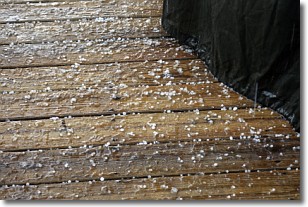Weather Alert in West Virginia
Flash Flood Warning issued May 13 at 5:46PM EDT until May 13 at 9:30PM EDT by NWS Charleston WV
AREAS AFFECTED: Braxton, WV; Gilmer, WV; Lewis, WV; Randolph, WV; Upshur, WV; Webster, WV
DESCRIPTION: FFWRLX The National Weather Service in Charleston has extended the * Flash Flood Warning for... Northeastern Braxton County in north central West Virginia... East Central Gilmer County in north central West Virginia... Western Randolph County in northeastern West Virginia... Southwestern Upshur County in northeastern West Virginia... North Central Webster County in northeastern West Virginia... Lewis County in northern West Virginia... * Until 930 PM EDT. * At 546 PM EDT, local law enforcement reported thunderstorms producing heavy rain across the warned area. Between 2 and 3 inches of rain have fallen. Additional rainfall amounts up to an inch are possible in the warned area. Flash flooding is already occurring. HAZARD...Flash flooding caused by thunderstorms. SOURCE...Law enforcement reported. IMPACT...Flash flooding of small creeks and streams, urban areas, highways, streets and underpasses as well as other poor drainage and low-lying areas. * Some locations that will experience flash flooding include... Weston, Rock Cave, Stonewall Jackson, Holly River State Park, Burnsville, Ireland, Walkersville, Kanawha Head, Cleveland, Falls Mills, Eden, French Creek, Sand Run, Horner, Hacker Valley, Alton, Alexander, Camden and Helvetia. Flooding was reported in the Weston and Walkersville areas.
INSTRUCTION: Turn around, don't drown when encountering flooded roads. Most flood deaths occur in vehicles. The saturated ground has produced conditions ripe for landslides and debris flows on steep slopes around the area. Residents with homes on or at the base of hillsides should be aware of the potential for landslides and watch for trees leaning in unusual orientations, water and mud seepage where not expected and other signs of potential ground movement. Report flooding to the National Weather Service by calling toll free, 800 401 9535, when you can do so safely.
Want more detail? Get the Complete 7 Day and Night Detailed Forecast!
Current U.S. National Radar--Current
The Current National Weather Radar is shown below with a UTC Time (subtract 5 hours from UTC to get Eastern Time).

National Weather Forecast--Current
The Current National Weather Forecast and National Weather Map are shown below.

National Weather Forecast for Tomorrow
Tomorrow National Weather Forecast and Tomorrow National Weather Map are show below.

North America Water Vapor (Moisture)
This map shows recent moisture content over North America. Bright and colored areas show high moisture (ie, clouds); brown indicates very little moisture present; black indicates no moisture.

Weather Topic: What is Rain?
Home - Education - Precipitation - Rain
 Next Topic: Shelf Clouds
Next Topic: Shelf Clouds
Precipitation in the form of water droplets is called rain.
Rain generally has a tendency to fall with less intensity over a greater period
of time, and when rainfall is more severe it is usually less sustained.
Rain is the most common form of precipitation and happens with greater frequency
depending on the season and regional influences. Cities have been shown to have
an observable effect on rainfall, due to an effect called the urban heat island.
Compared to upwind, monthly rainfall between twenty and forty miles downwind of
cities is 30% greater.
Next Topic: Shelf Clouds
Weather Topic: What is Sleet?
Home - Education - Precipitation - Sleet
 Next Topic: Snow
Next Topic: Snow
Sleet is a form of precipitation in which small ice pellets are the primary
components. These ice pellets are smaller and more translucent than hailstones,
and harder than graupel. Sleet is caused by specific atmospheric conditions and
therefore typically doesn't last for extended periods of time.
The condition which leads to sleet formation requires a warmer body of air to be
wedged in between two sub-freezing bodies of air. When snow falls through a warmer
layer of air it melts, and as it falls through the next sub-freezing body of air
it freezes again, forming ice pellets known as sleet. In some cases, water
droplets don't have time to freeze before reaching the surface and the result is
freezing rain.
Next Topic: Snow
Current conditions powered by WeatherAPI.com




